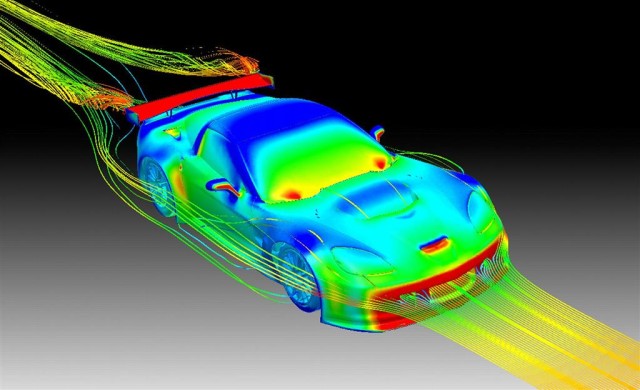 American and European auto manufacturers experimented with fuel injection as early as the 1930s, but it was not until the 1990s that fuel-injected vehicles invaded dealerships nationwide, and long gone were the days of the carburetor.
American and European auto manufacturers experimented with fuel injection as early as the 1930s, but it was not until the 1990s that fuel-injected vehicles invaded dealerships nationwide, and long gone were the days of the carburetor.
Automakers’ quest to control fuel more efficiently, while improving performance, eventually led to a boom in automotive electronics. Demands for cleaner emissions and improved safety and comfort features, resulting in the highly-sophisticated computerized network of today’s vehicles.
Among the American pioneers, one carmaker leaped to the forefront by introducing its first gasoline fuel-injected vehicle in 1956. That futuristic automobile was a Chevrolet, and not just any Chevy, but the Rochester Ramjet fuel injected Corvette. Corvette’s fuel injection was quite an innovation, especially since most manufacturers did not introduce fuel injection until the 1980s.
As we reported in our article “Bow Tie Breakthroughs: Chevrolet’s Ramjet Fuel Injection,” the system’s internal fuel meter adjusted the amount of fuel flow based on engine load and RPM. The Ramjet was a continuous-flow fuel injection system that delivered fuel to all of the cylinders simultaneously from a central “spider” of injection lines. It included a fuel reservoir similar to a carburetor’s float chamber.
In 1957, Chevy did it again by introducing the first Corvette “Fuelie.” Along with Corvette’s first four-speed manual transmission, it was available in two options boasting 250 or 283 horsepower. Power continued to increase, and by the time the last Fuelie made its last appearance in 1965, it was generating up to 375 horsepower.
The Fuelie produced one horsepower per cubic inch of displacement and was considered a significant milestone in gasoline-engine performance, achieving zero to 60 mph in six seconds with a top speed of 132 mph. The last production incorporated a “Crossfire” throttle body injection (TBI) system and two computers. The mechanical fuel metering adjustments of the Ramjet were now a thing of the past.
Smart ‘Vette!
The first Corvette ECM, or engine control module, also made its appearance in the 1982 model. Still a primitive box that responded to numbers or “signals,” the computer or “module” knew that if it was given a zero, its response would be a one, and so on indefinitely — a basic binary system. The new engine module collected information from sensors with devices used to perform the required tasks acting as the actuators. While this may sound like something from a” Transformers” movie, the system is quite simple and elegant in design.
Composed of two wires capable of carrying the data transmission between modules, the interaction between these computers is referred to as BUS Communications. The digital data uses unique computer languages, or voltage signals, so each computer on the network recognizes its signal and proceeds accordingly. The beauty of the system is that several commands, or hundreds of thousands of bits of data, can ride on the BUS at the same time.
The transition from carburetion to fuel injection, and from mechanical to electronic, was a difficult time for the automotive repair industry. Technology accelerated rapidly and understanding the new computerized vehicles required highly technical and specialized factory training. The first modules were still unknown and not as user-friendly as the highly-sophisticated modules of today. The new computer controlled vehicles were hard to diagnose, and it took a decade before the technician-to-module communication became the new norm in every automotive repair shop.
Sensors And Actuators
The first sensors were in charge of sending information to the engine module on conditions that would affect fuel delivery. These included an oxygen sensor (O2), throttle position sensor (TPS), coolant temperature sensor (CTS), manifold absolute pressure sensor (MAP), and vehicle speed sensor (VSS), among others.
The oxygen sensor, also known as a lambda sensor, is designed to detect the amount of oxygen that is left in the exhaust after combustion. Too much oxygen means the engine is running lean, or not receiving enough fuel. Too little oxygen means the engine is running rich or using too much fuel.
Based on information from the oxygen sensor, the engine module makes minor corrections to bring the fuel-to-oxygen ratio within manufacturer predetermined parameters. Also known as the stoichiometric ratio, it is the perfect combination of air and fuel and burns for optimal engine performance.
The TPS is connected to the accelerator pedal, and when pressed, it opens the air passage into the engine. The internal sensor detects this movement and sends an electrical signal to the engine module. The engine module interprets the signal as different stages of acceleration and commands its actuators — in this case, the fuel injectors — to inject more fuel. It does so by applying a voltage to the injectors causing them to open (like an on/off switch), and fuel pressure does the rest. The amount of time an injector is commanded on determines the amount of fuel injected. For every signal sensed there is an actuator response.
The ECT is a hierarchy sensor in the underhood network, acting as a thermistor-type sensor in that its voltage signal to the computer changes with variations in temperature. In response to reaching operating temperature, the engine computer activates the electric cooling fan in a simple input-processing-output format. The ECT signal is crucial during all driving conditions. Skewed signals from the ECT can cause no-start conditions, lack of power, and erratic transmission shifts, among other symptoms.
The MAP, also a hierarchy sensor, measures the lack of atmospheric pressure or vacuum inside the engine, while the VSS measures the speed at which the car is traveling. All of the signals from these sensors combine to relay information the engine module needs to achieve a perfect stoichiometric combustion ratio.
GM was also the first manufacturer to introduce a diagnostic test port where a technician could connect a scan tool and communicate with the engine computer, that nowadays incorporates one of the most user-friendly diagnostic systems in the industry.
Too Many Wires!
Computers, sensors, and actuators translated into more wiring in the car. As more comfort, safety, and emission controls were added, it became necessary to simplify the amount of wiring needed to execute all these electrical functions. The method of simplifying the wiring is referred to as multiplexing. Instead of more wiring, more modules were installed to monitor and command different sections and features — giving birth to the controller area network, or CAN system.
One of GM’s automotive communication networks, CAN powers up the second it receives a signal from the vehicle’s key transmitter. The modules necessary to disable the alarm, unlock doors, turn on lights, and start the vehicle wake-up and electrical signals, transmit among modules at speeds of up to 500 kilobytes per second. If one of the modules does not communicate, the engine computer may decide to turn the fuel injectors off and prevent the vehicle from starting. Because the CAN has the ability to self-diagnose issues, the engine and sensitive electronic circuits are protected from further damage.
The ECM is the most powerful computer in the car. Among its many duties, it also performs a smog check every time the vehicle is driven. The engine control module monitors and controls air intake, fuel delivery, combustion timing, and emission controls. When these events fall out of set parameters, the vehicle’s emissions increase due to improper air-to-fuel ratio, or a malfunctioning emission control. The engine module detects these malfunctions and the service engine light is illuminated. When an auto technician connects a scan tool to the vehicle, it communicates with the other modules through the CAN network to access diagnostic codes and other information the technician uses to diagnose and repair.
Corvette Evolution
The last Corvette with throttle body injection was the 1984 C4. The new 1985 Corvette model introduced tuned port injection to the 5.7-liter V8 engine and boosted horsepower to 230. In a multiport injection system (MPI) every cylinder has a designated fuel injector that is individually controlled by the ECM for extremely precise fuel delivery and correction.
 Correction occurs when the computer, via information from the oxygen sensor, determines that too much fuel was delivered. In response, it will shorten the injector on time for the next combusting cylinder, thus injecting less fuel. The engine computer’s ultimate quest is to always achieve perfect stoichiometry.
Correction occurs when the computer, via information from the oxygen sensor, determines that too much fuel was delivered. In response, it will shorten the injector on time for the next combusting cylinder, thus injecting less fuel. The engine computer’s ultimate quest is to always achieve perfect stoichiometry.
Each module in the automotive network performs millions of algorithm calculations per second and can output hundreds of trouble codes for a myriad of possible malfunctions. In 1986, Corvette introduced antilock brakes (ABS) as a standard option. With the new system, a new module — the GM electronic brake control module or EBCM was also introduced. By 1987, horsepower climbed to 240 and up to 345 in the twin-turbo Callaway model. Digital instrument clusters also appeared on Corvettes during the 1980s.
The new computerized systems became known as on-board diagnostics (OBD), and by 1996, the second generation of OBD standardized the computer language among all manufacturers, meaning a diagnostic trouble code for an engine performance problem is the same code used for every manufacturer. The modules’ self-diagnostics is a pass-fail system that generates DTCs, takes corrective actions as needed, and learns from its mistakes and achievements.
The early 2000s introduced the C5 and boasted up to 15 onboard computers. Today, it is not uncommon for vehicles to incorporate a network of more than 20 modules. By the time the C7 was introduced in 2013, the Corvette network already included such sophisticated modules as a vehicle performance data recorder, human machine interface control module, telematics communication interface module, tire pressure indicator module, and even a parking brake control module, among others.
Corvette’s technological innovations sure make our “Transformers” movie comparison not so far-fetched, after all. With 27 onboard computers and counting, we can only imagine what the C8 will be capable of doing. The sky is no longer the limit.





















